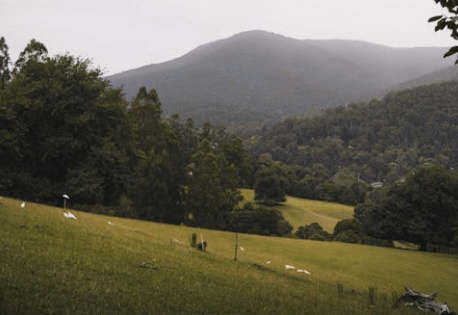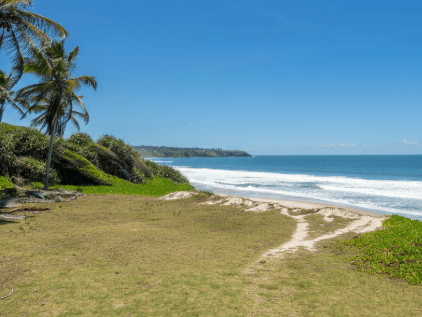Buying land can be rewarding, offering financial gains and personal satisfaction. The terrain on which land is situated significantly influences its utility, value, and possible challenges. Read on as we explore the intricacies of buying land in different types of terrain, including mountains, plains, and coastal areas. Whether you’re looking for a serene mountain retreat, a sprawling estate on the plains, or a picturesque coastal property, this guide on buying land in different types of terrain will provide valuable insights and advice.
As experienced real estate investors, Steve Daria and Joleigh emphasize the importance of understanding each terrain type’s specific challenges and opportunities. Whether it’s the potential for breathtaking views and seclusion in mountainous regions, the plains’ expansive and versatile nature, or the high desirability and erosion risk in coastal areas, each terrain offers unique considerations. Utilize their expertise to make informed decisions that resonate with your investment objectives and terrain preferences.
Understanding Different Types of Terrain
When considering buying land in different types of terrain, it’s essential to understand the characteristics and challenges associated with different types of terrain.
Each terrain type, whether it’s mountainous, plain, or coastal, offers unique opportunities and potential obstacles that can impact your investment and lifestyle choices.

Mountains
Mountainous terrain offers breathtaking views and a sense of serenity, but it also comes with unique challenges.
Considerations:
- Slope Stability: Ensure the land is stable enough for construction.
- Access and Infrastructure: Building roads and infrastructure can be costly and complex.
- Regulations: Mountain areas may have stricter building codes and environmental regulations.
Tips:
- Hire Geotechnical Experts: Conduct thorough soil and slope stability tests.
- Plan for Accessibility: Design driveways and access routes that can handle steep inclines.
- Respect Nature: Incorporate sustainable practices to minimize environmental impact.
Examples:
- Building a luxury retreat in the Blue Ridge Mountains.
- Developing a ski resort in the Rocky Mountains.
Plains
Plains are flat, expansive land areas ideal for agriculture and large-scale developments.
Considerations:
- Flood Risk: Flat areas can be prone to flooding.
- Soil Quality: Evaluate the soil for agricultural potential or construction suitability.
- Infrastructure: Easier and cheaper to develop compared to hilly or mountainous areas.
Tips:
- Flood Mitigation: Implement drainage systems and elevate structures if necessary.
- Soil Testing: Conduct tests to determine soil fertility and stability.
- Maximize Space: Utilize the expansive land for large-scale projects.
Examples:
- Developing a sizeable agricultural farm in the Midwest.
- Constructing a suburban housing development in Florida’s interior plains.
Get Started: Get Your Cash Offer Below…
We are direct land buyers. There are no commissions or fees and no obligation whatsoever. Start below by sharing where your property is and where we can send your offer…
Forests
Forested terrain can provide a natural, tranquil setting but requires careful planning.
Considerations:
- Clearing Land: Clearing land involves removing trees and vegetation and can be labor-intensive and regulated.
- Wildlife Conservation: Be mindful of local wildlife and habitats.
- Fire Risk: Proper fire management and safety measures are crucial.
Tips:
- Selective Clearing: Preserve as much natural vegetation as possible.
- Wildlife Protection: Work with conservationists to protect local species.
- Fire Safety: Create defensible space around structures and implement fire-resistant materials.
Examples:
- Building eco-friendly cabins in the Pacific Northwest.
- Creating a nature retreat in the forests of northern Florida.
Deserts
Desert terrain offers unique development opportunities but poses significant challenges.
Considerations:
- Water Supply: Access to water is a primary concern in desert areas.
- Extreme Temperatures: High temperatures can affect construction materials and living conditions.
- Sustainability: Emphasize sustainable practices to mitigate environmental impact.
Tips:
- Water Management: Invest in water-saving technologies and infrastructure.
- Climate Adaptation: Use materials and designs that withstand extreme temperatures.
- Green Building: Incorporate renewable energy sources like solar power.
Examples:
- Developing a solar farm in the Arizona desert.
- Creating a luxury resort in the Nevada desert.
Coastal Areas
Coastal terrain offers stunning views and high property values but comes with its own set of risks.
Considerations:
- Erosion and Flooding: Coastal areas are vulnerable to erosion, storms, and rising sea levels.
- Environmental Protection: Protecting marine and coastal ecosystems is crucial.
- Insurance Costs: Higher insurance premiums due to natural disaster risks.
Tips:
- Erosion Control: Implement sea walls, vegetation, and other erosion control measures.
- Sustainable Development: Use environmentally friendly building practices.
- Risk Assessment: Conduct thorough assessments to understand and mitigate risks.
Examples:
- Developing oceanfront properties in Miami.
- Building vacation homes on the Gulf Coast.

Strategies When Buying Land in Different Types of Terrain
Developing strategies tailored to each terrain type is crucial for making informed land purchases.
This section will explore effective approaches for buying land in different types of terrain, ensuring that you maximize the potential of your investment.
Research and Due Diligence
Thorough research is the foundation of any successful land purchase.
Understanding each terrain type’s unique characteristics and challenges ensures you select land suitable for your needs and goals.
This involves studying the soil composition, topography, climate, and accessibility of the land to identify potential obstacles and advantages early in the planning process.
Environmental Impact Assessment
Administer an environmental impact assessments to evaluate the potential effects of your development on the surrounding ecosystem.
These assessments help identify critical areas that need protection and inform sustainable development practices.
By understanding the environmental implications, you can make informed decisions that minimize harm to local wildlife and habitats while complying with environmental regulations.
Collaborate with Experts
Engage with geotechnical engineers, environmental consultants, and local authorities to ensure adherence to regulations and industry standards.
Geotechnical engineers can assess soil stability and suitability for construction, while environmental consultants can guide you on mitigating impacts on the ecosystem.
Collaborating with local authorities ensures that your development plans align with zoning laws and community standards, helping to avoid legal issues and delays.
Financing and Budgeting
Consider the additional costs associated with buying land in different types of terrain, such as infrastructure, erosion control, and environmental protection.
Budgeting for these expenses from the outset can prevent financial shortfalls and ensure your project stays on track.
Understanding the full financial scope allows for better strategies and resource allocation, ultimately leading to a more prosperous and cost-effective development.
Long-Term Planning
Think about the long-term sustainability of your project.
How will the terrain and environmental factors impact your property in the future?
Consider potential challenges such as climate change, natural disasters, and land degradation.
By planning for these long-term issues, you can implement strategies that enhance the durability and resilience of your development, ensuring it remains viable and valuable for years to come.
Conclusion
Buying land in different types of terrain requires a more profound knowledge of the unique challenges and opportunities each landscape presents. Each terrain offers distinct possibilities for development, from the majestic mountains to the serene coastlines. By conducting thorough research, collaborating with experts, and implementing sustainable practices, you can navigate the complexities of land purchases and make informed decisions that align with your goals.
Whether you are a land developer, land buyer, property owner, or real estate investor, this guide provides valuable information to help you succeed in your land acquisition endeavors. Remember, the key to a successful land purchase lies in understanding the terrain and leveraging its potential to create lasting value.
**NOTICE: Please note that the content presented in this post is intended solely for informational and educational purposes. It should not be construed as legal or financial advice or relied upon as a replacement for consultation with a qualified attorney or CPA. For specific guidance on legal or financial matters, readers are encouraged to seek professional assistance from an attorney, CPA, or other appropriate professional regarding the subject matter.
